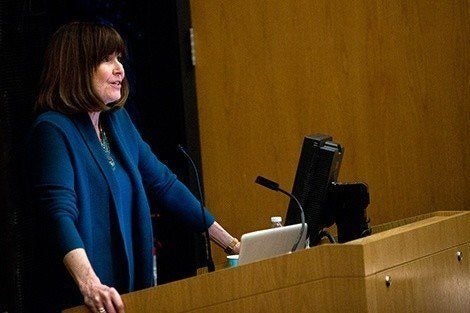March 18, 2015 — People often claim to ignore advertisements, but the messages are getting through on a subconscious level, pioneering author and ad critic Jean Kilbourne told an audience at Harvard T. H. Chan School of Public Health on March 3, 2015. Kilbourne, best known for her groundbreaking documentary on images of women in the media, Killing Us Softly, went on to deconstruct the subconscious messages in food and body image-related advertisements and to describe how they create a “toxic cultural environment” that harms our relationship with what we eat.
The event was sponsored by the STRIPED program (Strategic Training Initiative for the Prevention of Eating Disorders), which is based at Harvard Chan and Boston Children’s Hospital, and co-sponsored by the School’s Health Communication Concentration and Department of Nutrition. Kilbourne praised the work of STRIPED in her talk, calling it “a terrific program that is making a difference.”
The average American encounters 3,000 advertisements every day, and spends a total of two years watching TV commercials in their lifetime, Kilbourne said. At the center of many of these ads is an image of idealized female beauty. Models are tall, slim, and light skinned, and digitally altered to ever-more unrealistic proportions.
“Women and girls compare themselves to these images every day,” Kilbourne said. “And failure to live up to them is inevitable because they are based on a flawlessness that doesn’t exist.” The American ideal of beauty has become so pervasive that 50% of three- to six-year-old girls worry about their weight. And on the island of Fiji, the arrival of television heralded a boom in dieting among women and girls who before then hadn’t realized that there was something wrong with them.
While advertising creates a disconnection between women — and men, to a lesser extent—and their bodies, it also offers food as a comforter and a proxy for human relationships, Kilbourne said. She showed images of ads offering chocolate as a substitute for a lover, and cookies presented as a way to get love from your children.
Alongside the chocolate ads are others that shame women for having an appetite for food, such as one that showed a pair of cinnamon buns hanging off a slim model’s hips. These images normalize disordered behaviors around food such as bingeing and guilt. “The bulimic is the ideal consumer,” said Kilbourne.
Kilbourne called for a transformation in the way we think about food. “The solution to obesity isn’t to make girls hate themselves,” she said. Instead of focusing on weight or BMI, they should be helped to turn their focus on being healthy and having energy. “If we learn to eat healthy, natural, preferably local food with pleasure, and if we exercise with pleasure, our bodies will get to the weight and shape and size that they were genetically meant to be.”
But real change won’t happen child by child, Kilbourne said. Public health practitioners need to focus prevention efforts on the environmental level. She called for warning labels and taxes on diet products, greater transparency in the use of Photoshop in advertising and fashion spreads, and media literacy education in schools, among other measures.
Photo: Emily Cuccarese
